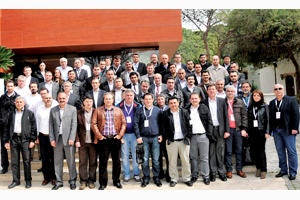First major seminar by Cobb Turkey

Seventy five delegates from the poultry meat sector across Turkey took part in a two-day seminar in north Cyprus, the first event on this scale by Cobb Turkey.
A team of Cobb technical experts shared their experiences and information on a wide range of topics including genetics, nutrition, hatchery, current health subjects and management techniques for parent and broiler stock.
David Beavers, processing specialist in the Cobb World Technical Support Team, explained cost structure of the US whole chicken sector, with feed, chick, plant and grower contributing 55%, 7%, 25% and 9% respectively.
He said the economic value ratio of different traits is dramatically different. For instance, 1% more carcass yield equals almost 10 eggs, and 1% more hatchability is worth three eggs, while one day less broiler growth equates to only 1.1 egg.
“The goal is to produce the most meat at the lowest cost,” said Beavers. “Yield is where the money is and the Cobb broiler has nearly 1% more yield than its competitors.”
Andrea Pizzabiocca, Cobb account manager for Italy, spoke about most important poultry viruses, referring to different infectious bronchitis substrains as still a headache for different parts of the world. For example, QX or D388 is the main reason for false laying in flocks infected in the first weeks of life. He said it was better to use variant vaccines rather than relying on partial cross-protection between subtypes.
Nutritionist Tony Marangos considered whether to aim for lower feed conversion and highest EPEF — or go for lowest feed cost/kg and stocking density. He said that Cobb broilers fed low density diets achieved excellent results in terms of meat cost. He added that Cobb diets are 25 dollars more cost effective than competitor formulations, equating to seven points in feed conversion.
Cobb hatchery specialist Mark Foote said high numbers of day-old chicks could benefit the hatchery but the ultimate goal must be for the overall benefit of the integration, for instance through high uniformity levels in processing.
He explained the impact of egg hygiene, breeders, storage, shell quality and ventilation on chick quality — and how important parameters such as chick quality, egg shell and cloaca temperatures, chick yield, chick uniformity and cull rates should be measured regularly in the incubators.
Cobb turkey was established in 2012 at Bandırma in the north west of Turkey. The hatchery there was redeveloped to be fully compatible with the Cobb worldwide standards and has a capacity of five million parent stock a year.













